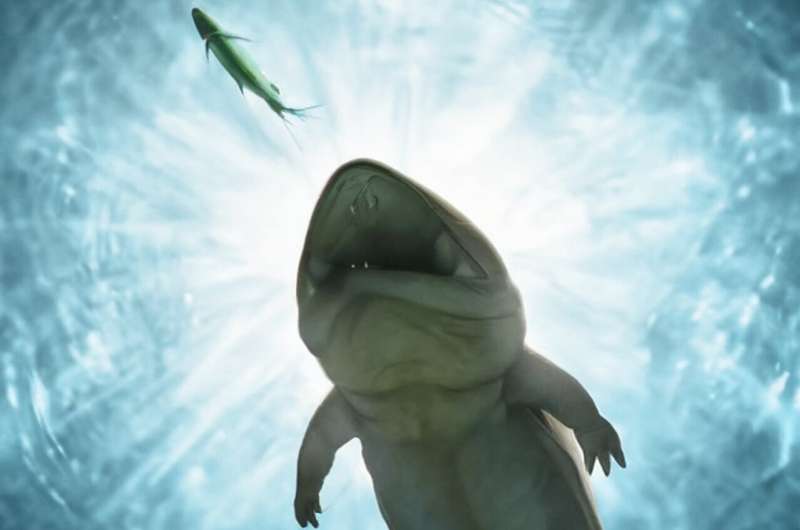
A surprising fossil, discovered by an Australian chicken farmer in the 1990s, has finally been identified as a remarkable amphibian with tusks and unique teeth, according to scientists.
The fossil, estimated to be 240 million years old, was found by Mihail Mihailidis as he cleaned a large sandstone slab that was originally intended to be a retaining wall for his garden.
Donated to the Australian Museum in 1997, the nearly intact specimen has intrigued scientists who have spent nearly three decades trying to determine its classification.
Lachlan Hart, paleontologist at the University of New South Wales, revealed that it has now been identified as a “heavyset” amphibian measuring 1.2 meters (nearly four feet) in length, resembling a cross between a crocodile and a giant salamander.
Hart suggested that the creature likely hunted freshwater fish using its distinctive teeth and “a pair of fang-like tusks on the roof of its mouth”.
“We rarely find skeletons with the head and body still attached, and finding preserved soft tissue is even rarer,” Hart said.
The creature has been given the scientific name “Arenaerpeton supinatus,” which translates roughly to “supine sand creeper”.
Hart explained that it belongs to a group of extinct animals known as “temnospondyls,” which existed before the time of dinosaurs.
Using a giant scanner typically used for cargo inspections, researchers conducted X-rays on the bulky fossil with the assistance of Australia’s border force.
The fossil was discovered in the mid-1990s near Umina Beach, a coastal town about an hour’s drive north of Sydney in New South Wales.
At the time, it received significant international attention, with Time Magazine speculating that it could “enhance the story of human evolution”.
“This is one of the most significant fossils found in New South Wales in the past 30 years, so it is exciting to formally describe it,” said Matthew McCurry, paleontologist at the Australian Museum.
“It represents a crucial part of Australia’s fossil heritage.”
More information:
Lachlan J. Hart et al, A new chigutisaurid (Brachyopoidea, Temnospondyli) with soft tissue preservation from the Triassic Sydney Basin, New South Wales, Australia, Journal of Vertebrate Paleontology (2023). DOI: 10.1080/02724634.2023.2232829
© 2023 AFP
Citation:
Scientists solve Australian chicken farmer’s fossil mystery (2023, August 12)
retrieved 12 August 2023
from https://phys.org/news/2023-08-scientists-australian-chicken-farmer-fossil.html
This document is subject to copyright. Apart from any fair dealing for the purpose of private study or research, no
part may be reproduced without the written permission. The content is provided for information purposes only.
Denial of responsibility! TechCodex is an automatic aggregator of the all world’s media. In each content, the hyperlink to the primary source is specified. All trademarks belong to their rightful owners, and all materials to their authors. For any complaint, please reach us at – [email protected]. We will take necessary action within 24 hours.

Jessica Irvine is a tech enthusiast specializing in gadgets. From smart home devices to cutting-edge electronics, Jessica explores the world of consumer tech, offering readers comprehensive reviews, hands-on experiences, and expert insights into the coolest and most innovative gadgets on the market.


